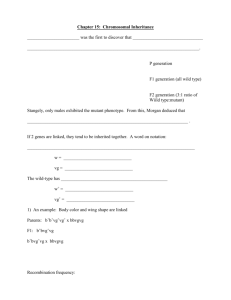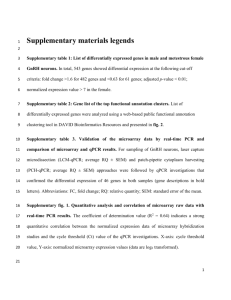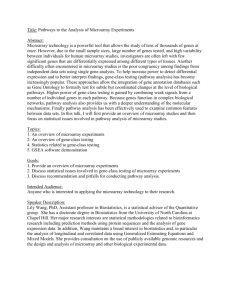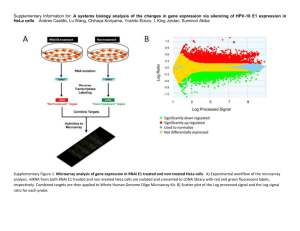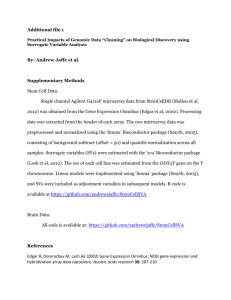Beneficiary Report
advertisement
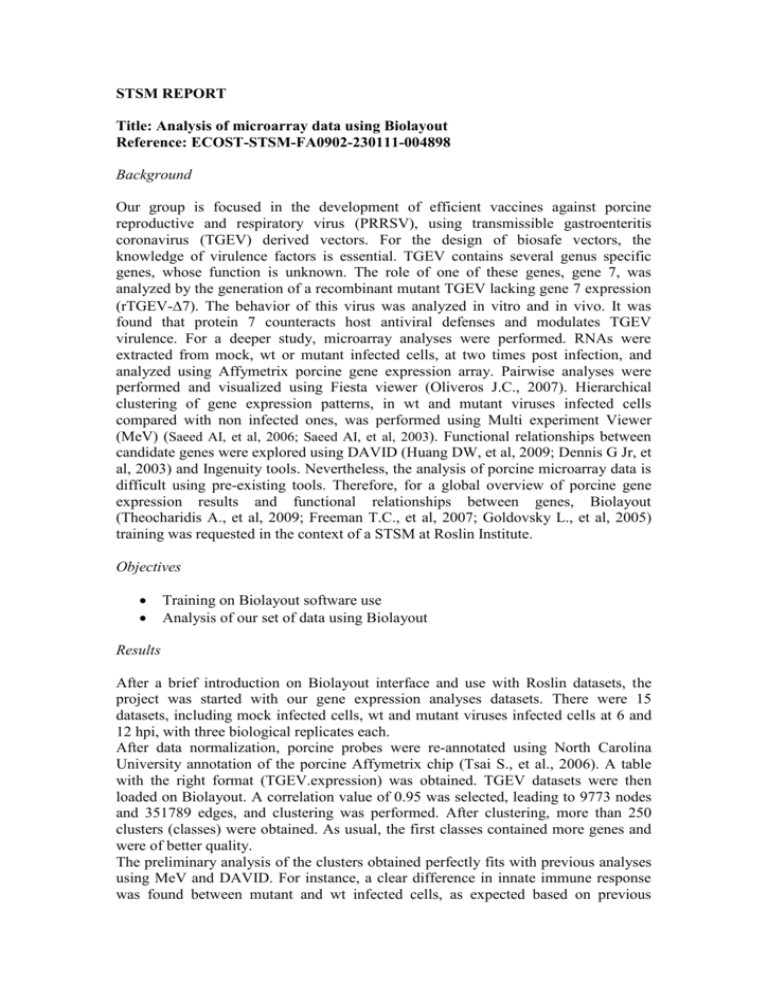
STSM REPORT Title: Analysis of microarray data using Biolayout Reference: ECOST-STSM-FA0902-230111-004898 Background Our group is focused in the development of efficient vaccines against porcine reproductive and respiratory virus (PRRSV), using transmissible gastroenteritis coronavirus (TGEV) derived vectors. For the design of biosafe vectors, the knowledge of virulence factors is essential. TGEV contains several genus specific genes, whose function is unknown. The role of one of these genes, gene 7, was analyzed by the generation of a recombinant mutant TGEV lacking gene 7 expression (rTGEV-7). The behavior of this virus was analyzed in vitro and in vivo. It was found that protein 7 counteracts host antiviral defenses and modulates TGEV virulence. For a deeper study, microarray analyses were performed. RNAs were extracted from mock, wt or mutant infected cells, at two times post infection, and analyzed using Affymetrix porcine gene expression array. Pairwise analyses were performed and visualized using Fiesta viewer (Oliveros J.C., 2007). Hierarchical clustering of gene expression patterns, in wt and mutant viruses infected cells compared with non infected ones, was performed using Multi experiment Viewer (MeV) (Saeed AI, et al, 2006; Saeed AI, et al, 2003). Functional relationships between candidate genes were explored using DAVID (Huang DW, et al, 2009; Dennis G Jr, et al, 2003) and Ingenuity tools. Nevertheless, the analysis of porcine microarray data is difficult using pre-existing tools. Therefore, for a global overview of porcine gene expression results and functional relationships between genes, Biolayout (Theocharidis A., et al, 2009; Freeman T.C., et al, 2007; Goldovsky L., et al, 2005) training was requested in the context of a STSM at Roslin Institute. Objectives Training on Biolayout software use Analysis of our set of data using Biolayout Results After a brief introduction on Biolayout interface and use with Roslin datasets, the project was started with our gene expression analyses datasets. There were 15 datasets, including mock infected cells, wt and mutant viruses infected cells at 6 and 12 hpi, with three biological replicates each. After data normalization, porcine probes were re-annotated using North Carolina University annotation of the porcine Affymetrix chip (Tsai S., et al., 2006). A table with the right format (TGEV.expression) was obtained. TGEV datasets were then loaded on Biolayout. A correlation value of 0.95 was selected, leading to 9773 nodes and 351789 edges, and clustering was performed. After clustering, more than 250 clusters (classes) were obtained. As usual, the first classes contained more genes and were of better quality. The preliminary analysis of the clusters obtained perfectly fits with previous analyses using MeV and DAVID. For instance, a clear difference in innate immune response was found between mutant and wt infected cells, as expected based on previous results. Additional differences were observed between wt and mutant viruses. As an example, genes belonging to cluster 5 were upregulated at 12 hpi in wt infected cells but not in mutant infected cells; genes in cluster 18 were only upregulated in wt infected cells, both at 6 and 12 hpi (Fig. 1). Figure 1. Biolayout results for clusters 5 (left) and 18 (right). Specific genes were also searched, based on previous knowledge. For instance, caspases expression was analyzed, as mutant virus induced a faster and stronger apoptosis than the wt virus. Biolayout results indicated that some caspase genes were upregulated in mutant virus compared with the wt one, and also that the expression pattern of different caspase genes was different, suggesting a differential involvement of each caspase in the virus induced apoptosis (Fig. 2). Figure 2. Biolayout results for caspase probes. Each color represents a cluster, in which each caspase was found. Dark blue, caspase 3; brown, caspase 4; light green caspase 6; emerald green, caspase 7. Conclusions Biolayout software was very useful for a global view of our microarray datasets. The obtained results fit with the previous preliminary results resulting form other microarray analysis softwares, such as MeV or DAVID. The Biolayout results also are in agreement with expected results based on experimental infections data. Therefore, Biolayout is a useful tool for all the people in our lab, and its use will be promoted. References Dennis G Jr, Sherman BT, Hosack DA, Yang J, Gao W, Lane HC, Lempicki RA. DAVID: Database for Annotation, Visualization, and Integrated Discovery. Genome Biol. 2003;4(5):P3 Freeman T.C., Goldovsky L., Brosch M., van Dongen S., Mazière P., Grocock R.J., Freilich S., Thornton J., Enright A.J. Construction, visualisation, and clustering of transcription networks from microarray expression data. PLoS Comput Biol. 2007; 3(10):2032-42 Goldovsky L., Cases I., Enright A.J., Ouzounis C.A. BioLayout(Java): versatile network visualisation of structural and functional relationships. Appl Bioinformatics. 2005;4(1):71-4 Huang DW, Sherman BT, Lempicki RA. Systematic and integrative analysis of large gene lists using DAVID Bioinformatics Resources. Nature Protoc. 2009;4(1):44-57 Oliveros, J.C., 2007. An interactive server for analyzing DNA microarray experiments with replicates. http://bioinfogp.cnb.csic.es/tools/FIESTA Saeed AI, Bhagabati NK, Braisted JC, Liang W, Sharov V, Howe EA, et al. TM4 microarray software suite. . Methods in Enzymology. 2006;411:134-93 Saeed AI, Sharov V, White J, Li J, Liang W, Bhagabati N, et al. TM4: a free, open-source system for microarray data management and analysis. . Vol 34.; 2003 Theocharidis A., van Dongen S., Enright A.J. and Freeman T.C. Network Visualisation and Analysis of Gene Expression Data using BioLayout Express3D. Nature Protocols 2009; Vol.4 No.10:1535-50 Tsai, S., J. P. Cassady, et al. (2006). "Annotation of the Affymetrix porcine genome microarray." Animal Genetics 37(4): 423-424


